
Cultural and sport activities are booming in Cao Sơn commune (Luong Son district), contributing to building a civilised cultural life, strengthening solidarity spirit, and successfully fulfilling local socio-economic development tasks.
Cao Sơn commune (Luong Son district) has installed fitness equipment systems, creating favourable conditions for local people to exercise and improve their health.
Every afternoon, the yard in front of Dam Da village cultural house is bustling with sports activities. Depending on preferences and age, people choose to practice the kind of sport that is suitable for their health such as volleyball and badminton.
Hoang Van Quy, a resident in Dam Da village, said that volleyball is the favourite sport of many villagers. Volleyball not only helps him improve his health but also provides an opportunity for him to meet and exchange with those who share the same passion, he continued.
In recent years, the cultural and sports movements in the commune have expanded in both quantity and quality. Among them, the "All people unite to build cultural life" movement is a typical example, which is associated with the "All people take exercise following the example of great Uncle Ho” movement.
All villages have their own art troupes which help preserve the cultural identity of the local Muong ethnic group. Folk dance clubs have also been established and operated regularly.
Regarding the sports movement, Cao Son commune is regarded as one of the outstanding areas in such sports as volleyball, archery and stick-pushing competitions. Teams of the commune have achieved high results in sports competitions at district-level.
Over 20% of the commune’s population regularly practise sports, with the most active ones being young people, women and the elderly. Volleyball and football clubs have been set up in all villages.
To promote the cultural and sports movements, local authority has directed agencies and mass organisations to maintain playgrounds which create a lively atmosphere and foster solidarity.
The commune organises cultural and sports activities as well exchange programmes on occasions such as national holidays. Investment is poured in upgrading cultural houses at villages to meet the criteria of new-style rural areas.
As a result, the cultural and spiritual life of local people has been improved. Last year, the per capita income in the commune reached 43 million VND (about 1,690 USD). Nearly 89% of households were recognised as cultural families and all villages met standards of cultural residential areas.
Bui Minh Chau, Vice Chairman of the People's Committee of Cao Sơn commune, said that in the coming time, local authorities will continue to direct agencies and organisations to encourage people’s active participation in cultural and sports activities. The commune will mobilise resources to build cultural infrastructure at the grassroots level as well as commend collectives and individuals with outstanding achievements in cultural and sports movements, thus contributing to the construction of new-style rural areas and civilised urban areas, he added.
With an increasingly vibrant and widespread emulation movement aimed at building cultured residential areas and cultured families, Yen Thuy District has been making steady progress toward improving both the material and spiritual well-being of its people, while fostering a civilized, prosperous, beautiful, and progressive community.
Once lacking recreational spaces and community facilities, Residential Group 2 in Quynh Lam Ward (Hoa Binh City) has recently received attention for the construction of a new, spacious, and fully equipped cultural house. The project followed the model of state support combined with public contributions in both labor and funding.
The "All people unite to build cultural life" movement, which has been effectively integrated with Kim Boi district’s socio-economic development goals, is fostering a lively spirit of emulation across local residential areas, hamlets, villages, public agencies, and enterprises. In addition, through the initiative, traditional cultural values are being preserved and promoted, while community solidarity and mutual support in poverty reduction and economic development are being strengthened.
A working delegation of the Hoa Binh provincial People’s Committee led by its Permanent Vice Chairman Nguyen Van Toan on June 11 inspected the progress of a project to build the Mo Muong Cultural Heritage Conservation Space linked to tourism services in Hop Phong commune, Cao Phong district.
Born and growing in the heroic land of Muong Dong, Dinh Thi Kieu Dung, a resident in Bo town of Kim Boi district, in her childhood was nurtured by the sweet lullabies of her grandmother and mother. These melodies deeply imprinted on her soul, becoming an inseparable part of her love for her ethnic group's culture. For over 20 years, this love for her hometown has driven Dung to research, collect, and pass down the cultural values of the Muong people to future generations.
In the final days of May, the Ethnic Art Troupe of Hoa Binh Province organized performances to serve the people in remote, mountainous, and particularly disadvantaged areas within the province. These were not just ordinary artistic shows, but they were the meaningful journeys aimed at spreading cultural values, enhancing the spiritual life of the people and contributing to the preservation of ethnic minority cultural identities.



